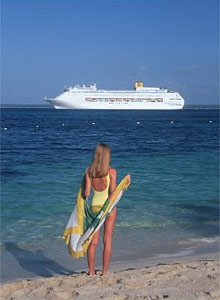 |
 |
 |
 Travel & Outdoors | March 2005 Travel & Outdoors | March 2005  
Cruise Prices to Surpass Pre-2001 Levels
 USATODAY.com USATODAY.com


| The investment on ships can cost up to $800 million. But the number of passengers has been growing by about 8% a year over several decades, so those ships sail full.

|
Ticket prices for cruise vacations should soon reach record highs that were set before the 2001 terrorist attacks and economic recession, expanding the cruise lines' already fat profits. Despite rising prices, cruise trips are still popular because they are usually cheaper than vacations on land, the officials said. The launching of far-bigger ships with new features like luxury spas and ice skating rinks mean consumers get more bang for their buck than on voyages 20 years ago, they said.

When taking inflation into account, cruises are an even better value, Carnival Cruise Lines President and CEO Bob Dickinson said at the annual Seatrade Cruise Shipping Convention. Some seven-day trips on the bargain Carnival brand cost about $599 in 1980 and remain that low today. And $599 in 1980 dollars is worth $1,373 today, he said.

"What a phenomenal value," said Dickinson, a relentless salesman who helped expand Carnival and its parent company, Carnival Corp., into the world's largest cruise company.

Carnival Corp. & PLC, the world's largest cruise company, and the other major companies, Royal Caribbean Cruises Ltd. and Star Cruises PLC, have seen demand and profits rise. More than 10.5 million people took cruises last year, and that increased the companies bottom lines to record levels.

A few rough spots do exist, though. The dollar's fall in value against the euro has made it more expensive to build new ships. Most cruises are bought in dollars, but the largest shipyards are in Europe and price contracts in euros.

Carnival has used its size to negotiate better deals on new ships, said Howard Frank, vice chairman and chief operating officer. Carnival now has 77 ships with 13 on order.

The exchange rate problem has caused cruise lines to slow down new orders. Last year, onboard capacity grew by a net 11.7%, while this year it is projected at 4.6%, UBS analyst Robin Farley said in a presentation.

But the companies must keep building to lure back customers, who are always looking for new features on ships. Older "ships aren't good enough to compete," Dickinson said.

The investment on ships can cost up to $800 million. But the number of passengers has been growing by about 8% a year over several decades, so those ships sail full.

Rising oil and fuel prices are also eating into profits. A few years ago, fuel costs were about 2% or 3% of Royal Caribbean's revenues; now they're about 5%, said Jack Williams, president and chief operating officer.

But cruise companies are much less sensitive about fuel prices than airlines, which use much more, said Colin Veitch, president and CEO of Star Cruises' Norwegian Cruise Line. For example, American Airlines parent AMR Corp. spent about 22% of revenues on fuel last year.

Carnival shares rose 44 cents to close at $54.51 in Tuesday trading on the New York Stock Exchange, near a 52-week high of $58.98.

Frank said higher fuel prices seem to be scaring away some investors, but that the company's performance will win them back. Carnival expects to earn $2.70 a share this year, up from $2.24 a share last year.

Royal Caribbean shares rose $1.82, or 4%, to close at $47.17 in Tuesday trading on the NYSE. The stock has been trading at a 52-week range of $37.80 to $55.47. | 
 | |
 |



